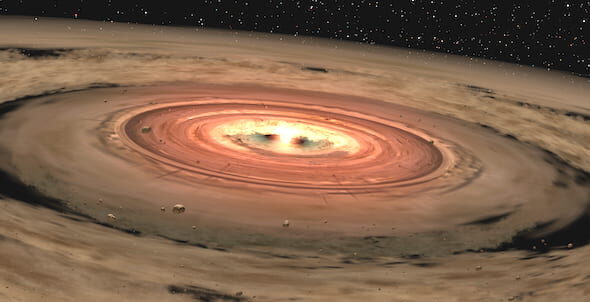A team of scientists from Rice University has shown that one primordial source of Nitrogen, a necessary building block for life was close to our home planet.
The isotopic signatures of nitrogen in iron meteorites reveal that Earth likely gathered its nitrogen not only from the region beyond Jupiter’s orbit but also from the dust in the inner protoplanetary disk.
The study by Rice graduate student and lead author Damanveer Grewal recently appeared in Nature Astronomy.
Previous Studies
“Researchers have always thought that the inner part of the solar system, within Jupiter’s orbit, was too hot for nitrogen and other volatile elements to condense as solids, meaning that volatile elements in the inner disk were in the gas phase,” Grewal said.
As the seeds of present-day rocky planets, also known as protoplanets, grew in the inner disk by collecting locally sourced dust, Grewal said it appeared they did not contain nitrogen or other volatiles. And thus researchers thought that nitrogen was delivered to Earth from the outer solar system.
A study in the past by the team suggested much of this volatile-rich material came to Earth via the collision that formed the moon.
Results of New Study
But new evidence clearly shows only some of the planet’s nitrogen came from beyond Jupiter.
In recent years, scientists have analyzed nonvolatile elements in meteorites, including iron meteorites that occasionally fall to Earth, to show dust in the inner and outer solar system had completely different isotopic compositions.
“This idea of separate reservoirs had only been developed for nonvolatile elements,” Grewal said. “We wanted to see if this is true for volatile elements as well. If so, it can be used to determine which reservoir the volatiles in present-day rocky planets came from.”
Iron meteorites are remnants of the cores of protoplanets that formed at the same time as the seeds of present-day rocky planets, becoming the wild card the authors used to test their hypothesis.
The researchers found a distinct nitrogen isotopic signature in the dust that bathed the inner protoplanets within about 300,000 years of the formation of the solar system. All iron meteorites from the inner disk contained a lower concentration of the nitrogen-15 isotope, while those from the outer disk were rich in nitrogen-15.
This suggests that within the first few million years, the protoplanetary disk divided into two reservoirs, the outer rich in the nitrogen-15 isotope and the inner rich in nitrogen-14.
“Our work completely changes the current narrative,” Grewal said. “We show that the volatile elements were present in the inner disk dust, probably in the form of refractory organics, from the very beginning. This means that contrary to current understanding, the seeds of the present-day rocky planets — including Earth — were not volatile-free.”
Dasgupta, a Rice faculty member, told that the current findings are significant in studying the potential habitability of exoplanets.
He also added that at least for our home planet, we now know that the entire nitrogen does not come only from the outer solar system.
Journal Reference:
Damanveer S. Grewal, Rajdeep Dasgupta, Bernard Marty. A very early origin of isotopically distinct nitrogen in inner Solar System protoplanets. Nature Astronomy, 2021; DOI: 10.1038/s41550-020-01283-y
Press Release: Rice University

